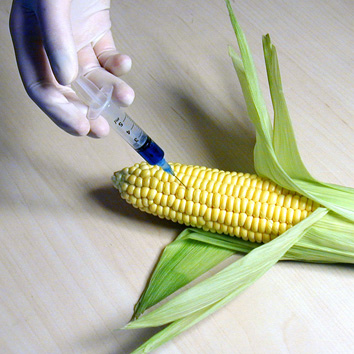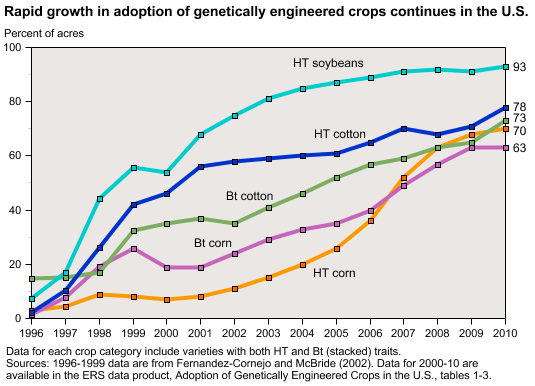About 85 percent of corn in the U.S. is genetically modified. Soy is the most heavily genetically modified food in America. Genetically modified squash and zucchini can be found in two different species throughout the country. Some of the most commonly purchased and consumed produce- and almost all of it is genetically engineered in some shape or form. Genetic modification is the process of altering an organism’s DNA to reveal or induce preferable qualities as it grows. Many common misconceptions have been surrounding GMOs (genetically modified organisms) after their rise to popularity in recent years. People speculate over their usefulness and if they’re even safe to consume or use in daily life. The reality of the situation is this: most accusations that these organisms are harmful to you or your children are insubstantial with there being either no evidence or very little of it to support the claim. GMOs are not only helpful, but in some cases necessary for us to maintain our current- and rising- population of about 7.4 billion people worldwide.
GMOs are unnatural- or are they?
Opposers of GMOs use the fact that these genetically engineered foods or products are unhealthy and unnatural, but this statement is not as correct as they’d like it to be. While it’s true that plenty of GMOs are a result of scientists at labs and universities tweaking the genetic makeup of otherwise organic life, the first genetically modified consumable was a product of nature itself around 8,000 years ago. A study from May of 2015 shows that a sweet potato, modified by bacteria in the soil it was planted in, has shaped all variants of the food we know and eat today. Jan Kreuze, a virologist who led the study, said, “People have been eating a GMO for thousands of years without knowing it.” We’ve been consuming GMOs for many, many years, and yet no harmful effects have been conclusively proven to exist.
The Effects- Superstition or Truth
The Myths; debunked
The positive effects of GMOs greatly outweigh the negatives, upon which scientists can’t even agree. There are several myths about the effects of GMOs on unborn infants, pregnant women, and other species of animals or plants. The first and arguably most prominent being that “toxins” were found in maternal and fetal blood after GMOs were consumed by pregnant women. The toxin was a protein known as Cry1Ab, which is commonly used as a pesticide. The study has since been debunked; the measurements made were supposed to detect the presence of the protein in plants, not humans. The women being monitored would have had to have eaten several kilos of corn to get the same measurements, and the other aspect is- so what? Human beings don’t have the correct genetic makeup to detect or use the protein, so it has no effect on us. The results were only meant to create fear and deceive people into hating or being afraid of GMOs and their effects.
A 2013 study says that an herbicide used on herbicide resistant GMOs induces breast cancer by affecting estrogen receptors. The paper, however, was flawed in many ways. The experiment used two lines of breast cancer cells, one estrogen sensitive and one not. They used these cells to investigate the results of increasing exposure to glyphosate, the herbicide, on both groups of cells. Initially, they found that it had a similar effect on the cells as estrogen did, but the relationship was weak, and had no effect on non estrogen-sensitive cells. The paper also lacked any data on the controlled aspect of the experiment, which is arguably the largest flaw in the entire study; there was no significant difference in the controlled cells versus the cells that received the highest exposure. This tells us that they omitted the control data so as to make us believe that the herbicide really poses a danger to us. In reality, glyphosate is completely harmless, and serves only to keep intrusive and unwanted vegetation away from what becomes our food.
The Facts
An article by Ken Mandel lists several benefits of commercial and widespread GMO use. The use of GMOs yield great positive effects, some of which are all but necessary to sustain life. GMOs provide substantial environmental benefits. Overall, they require fewer chemicals, fewer workers, less time, and less land to flourish and grow. GMOs enhance productivity by taking up less area and providing more to be harvested per square area of land. They reduce greenhouse emissions, soil erosion, and environmental pollution. Besides that, GMOs also produce natural pesticides and herbicides, which reduces or even eliminates the need for chemical based solutions that can actually cause bodily harm.
Genetically modified consumables also provide better nutritional value. Scientists can alter vitamins and other nutrients to be more plentiful in a certain crop, and in doing so can fight world hunger. Ken tells us in the article that “vitamin A-enhanced rice, or ‘golden rice,’ is helping to reduce global vitamin A deficiencies.” Without GMOs, more people would go hungry all around the world.
Although there’s still some debate on the safety of GMOs, most scientists and even some parts of the government have put their stamp of approval on all genetically engineered consumables or processes that end up on your dinner table. The Food and Agriculture Organization of the United Nations approve and support the use of GMOs for their overall productivity, as well as their by products such as proteins and vaccines. An article from TIME magazine tells us that the United States Department of Agriculture and the Food and Drug Administration have both approved several types of GMOs, including corn, soybean, and cotton.
The Verdict
It’s clear now that GMOs do far more good than harm, not just for us here in the U.S., but for everyone around the world. They’re good for business, good for the environment, and good for all of us. The current scientific consensus on GMOs is that they’re completely harmless and completely useful, but a scientific consensus is subject to change if sufficient evidence is presented. The studies that I’ve shown you here along with every other study that’s been conducted regarding their safety have been unable to change that consensus. GMOs are the next step into a better, brighter future.




I strongly agree with everything you said in this blog.
I strongly disagree with just about everything you said in this blog.
Much love Dylan <3